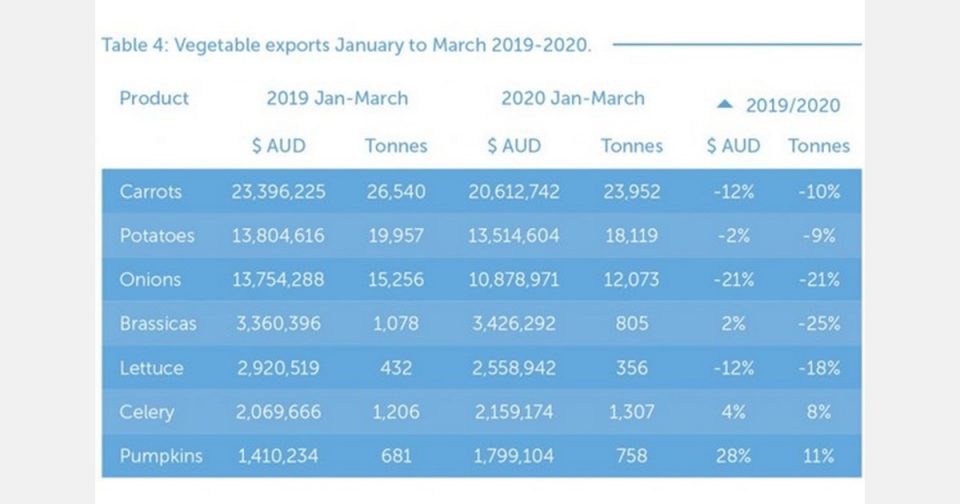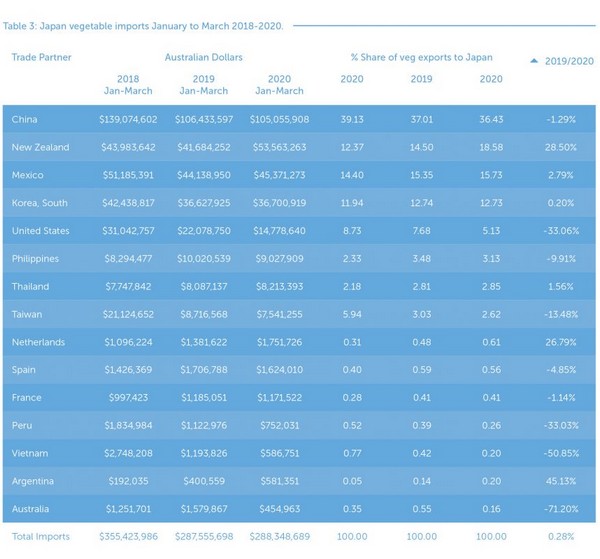The emergence of the COVID-19 pandemic has led to an uncertain start to the year for levy-paying vegetable grower-exporters. Market closures, supply chain disruptions and air and sea freight services being ceased or heavily reduced are examples of some of the challenges exporting growers have faced in the first quarter of 2020. AUSVEG National Manager – Export Development Michael Coote reports.
Vegetable exports have continued during the first quarter of 2020 as the COVID-19 crisis worsened. According to the latest data from Global Trade Atlas, the total value of vegetable exports for the period from January to March 2020 was $59.5 million, a decrease of 8.7 per cent from the corresponding period in 2019. Total vegetable export volume dropped to 58,276 tonnes, representing a 12 per cent decrease over the same period (see Table 1).
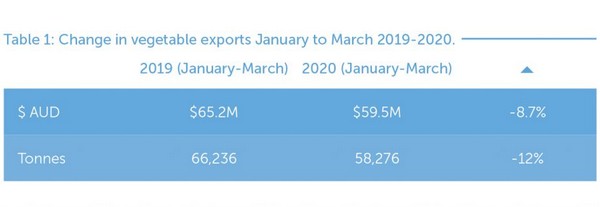
Exports by destination market
Looking to the primary vegetable export markets, trade to Singapore was up by $983,798 to $11,207,437, an increase of 10 per cent in value. However, it was down 48 tonnes to 6,462 total tonnes for the period – a decrease of one per cent. Trade to the United Arab Emirates saw a decline of three per cent in value and volume. Saudi Arabia rose 10 per cent in value and 17 percent in volume. Trade to Hong Kong was lower than the previous year, down 14 per cent by value and down seven per cent by volume. The most significantly impacted market was Japan, down 70 per cent in value and 78 percent in volume (see Table 2).
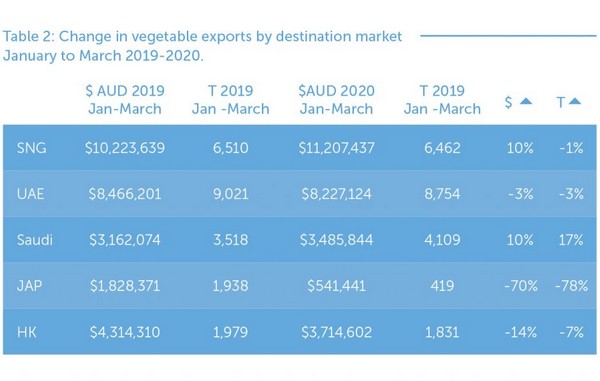
Japan in focus
In recent years, the value of vegetable exports to Japan in the first quarter averaged $1.3 million; however, from January to March 2020 export value totalled $454,963, a reduction of 71 per cent (see Table 3).
This is despite total Japanese vegetable imports growing by 0.28 per cent from last year. This indicates a reduction in the share of Australian vegetable exports into Japan for the period as supply is replaced from other trading partners, in addition to a reduction in the asparagus trade this season. This is the largest reduction of any single trading partner to Japan.
Exports by crop
Demand for celery, brassicas and pumpkins remained strong in export markets. Exports of carrots, potatoes, onions and leafy salads were down considerably on the same period in 2019 (see Table 4).
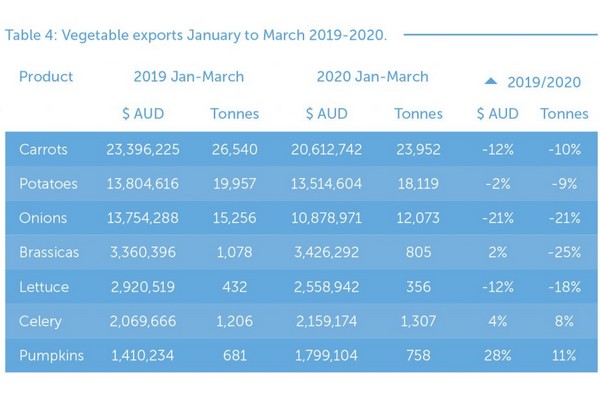
Factors affecting vegetable exports during COVID
A wide range of environmental and domestic market factors can influence the amount of vegetable production that is directed to export markets, and this can vary greatly by crop. Downward pressure on the Australian Dollar made Australia’s vegetable exports more competitive in international markets.
From January to March 2020, the Australian Dollar was as high as US$0.63 and as low as US$0.55 – the lowest level for the AUD/USD since 2003. Staple vegetable produce lines experienced robust demand and ongoing enquiries from export markets.
Many countries are experiencing difficult economic conditions and increasing unemployment; however, consumers are still seeking staple vegetables – possibly instead of higher-value discretionary fresh produce purchases.
Access to critical freight services has been mixed depending on the mode of transport; in some cases, the ability to get product out of the country has been significantly impacted.
This applies particularly to air freight, which has reduced in availability and affordability:
Air freight has been reduced by up to 91 per cent from pre-COVID levels. In April, the Federal Government announced the International Freight Assistance Mechanism, a AUD$110 million stimulus package to get more planes in the sky to ensure that important agricultural and aquaculture products can be supplied to export markets, with backhaul flights bringing in critical medical supplies to add to the national stockpile.
Sea freight has been less disrupted than air freight. Some container shipping companies are cancelling sailings and merging routes to cut losses and stay afloat amid a drop in demand and a worsening outlook for global trade. The number of “blanked” or cancelled sailings has increased, however the focus has not been to reduce Australia routes. Reports are that the largest capacity withdrawal has been from the Asia-Europe routes, where around one-third of capacity has been removed.
Beyond COVID-19 – questions the Australian industry will face
Food security and self-sufficiency: If countries remain concerned about domestic food security once the initial crisis has passed, they may be tempted to impose additional protectionist policy measures.
This may be an ongoing issue as the economic effects of the crisis flow through international economies. It is important that interim measures implemented during the COVID-19 response do not become long term or jeopardise the multilateral trading system.
Economic uncertainty and increased unemployment: International economies will recover at different rates, depending on the resilience of their individual economies and the response to managing the economic and health risks of COVID-19.
This may lead to a lead to a change in the ability of some markets to import Australian vegetables; however, the primary markets for vegetable exports are expected to remain relatively stable. More than ever, exporters will need to consider the economic conditions in their markets and consider the financial credentials of their customers over the medium to long term.
Freight and travel: The impact from COVID-19 on international freight networks may be considerable.
The ongoing viability of various shipping routes and profitability of shipping lines may lead to changes in the services provided to and from Australia. Global airlines will increasingly see their fleets back in the sky carrying passengers and cargo, but it is likely to be a staged reopening of countries and airports with routes disrupted from further COVID-19 fallout.
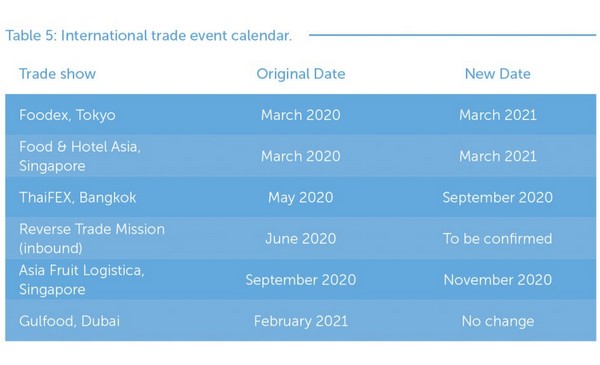
International trade events 2020/21
Through the Vegetable Industry Export Program (VG16061), a strategic levy under the Hort Innovation Vegetable Fund, AUSVEG coordinates grower participation in several international trade missions aligned with major tradeshows. Many of these events have been postponed or deferred until 2021. See Table 5 for the updated calendar.
For more information:
AUSVeg
Tel: +61 3 9882 0277
Email: [email protected]


